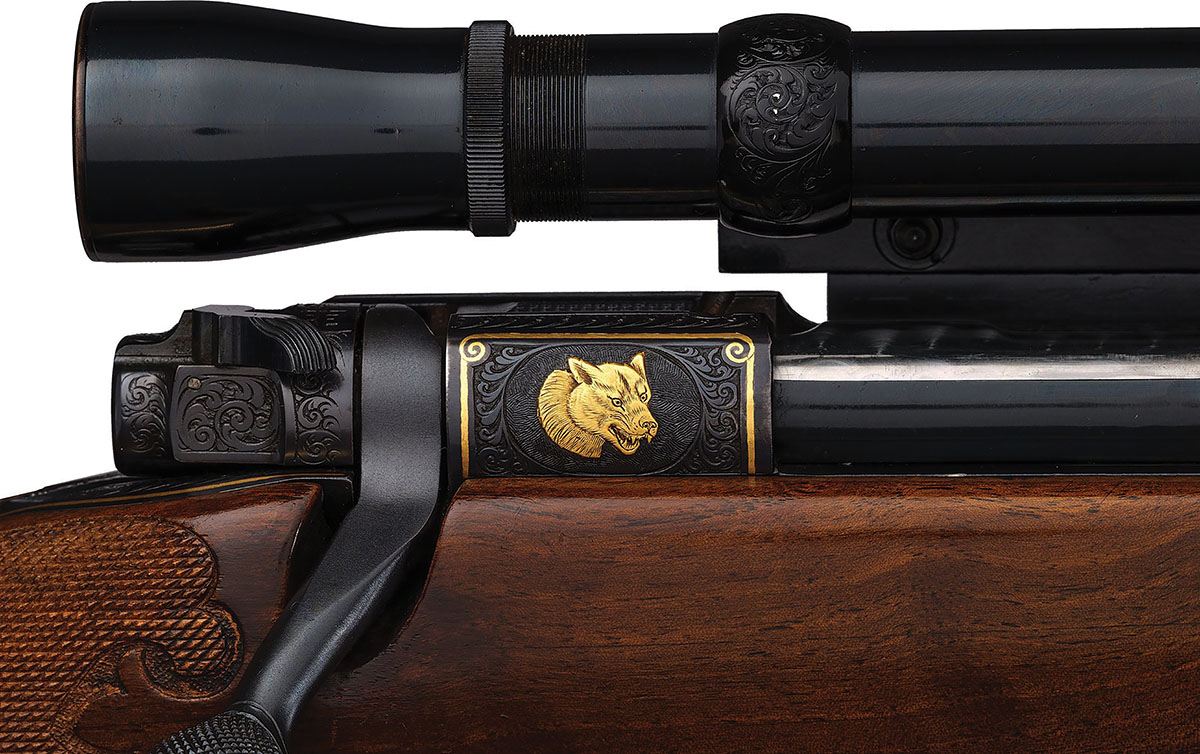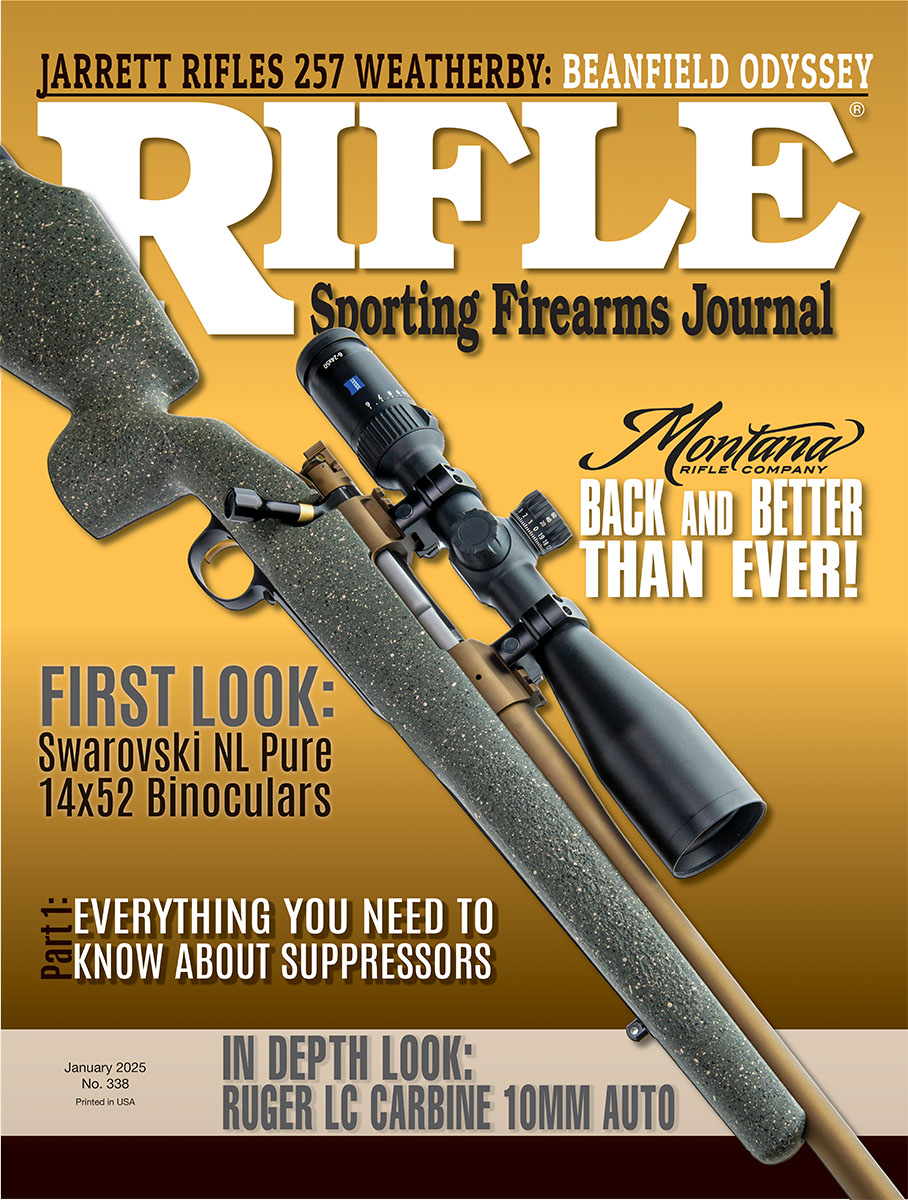Walnut Hill
Alive and Well
column By: Terry Wieland | January, 25

The “pre-’64” designation can be applied to other Winchester guns that were redesigned during the infamous retooling of the New Haven factory that took place under its new, Ford Motor Company-trained upper management in the early ’60s. But when you say “pre-’64,” most expect you’re referring to the Model 70. It was, and is, the icon.
The Model 70 grew out of the earlier Model 54 bolt action, which was very obviously derived from the Mauser ’98. It has dual opposing locking lugs, a claw extractor, controlled feeding from a box magazine, and a unique three-position wing safety that allows low scope mounting.
No one ever claimed the Model 70 was the most accurate rifle ever to come along, but it was accurate enough for most, and could be made more so for the cognoscenti. You can wriggle and squirm and cavil about this action or that being intrinsically more accurate for this purpose or that, but the pre-’64 Model 70 had other virtues that tipped the balance.
First, it was made from excellent steel, carefully machined and fitted. Its parts could be honed and polished by a good gunsmith to function like buttered silk. Its stocks were walnut, and while generally not extravagant, had good color and grain structure.
The Model 70’s second virtue was that it was tasteful and stylish. Whoever did the final design had an eye for grace and line, from the arc of the pistol grip through the trigger guard and floorplate, to the taper of the barrel. The pre-64 was not the father of the style that later became known as “American classic,” but it certainly embodied those principles of understated elegance.
Somewhere along the line it was dubbed “the rifleman’s rifle.” How much that added to the mystique, who knows? But the name stuck and was used as the clinching argument in hunting-camp debates. (Don’t laugh. I’ve heard it myself.)
The replacement in 1964 was also called the Model 70, and was referred to as “post-64.” Broadly speaking, it simplified manufacturing by cutting corners and eliminating certain features. Most notably, it did away with the claw extractor and controlled-round feeding, and redesigned the barrel-breech arrangement. In the 1965 Gun Digest, writer and big-game guide Bob Hagel did a “Testfire” piece in which he compared the performance of Model 70s old and new, and determined that the post-’64 was both stronger and more accurate.
Maybe so. But all the strength and accuracy in the world could not make up for its short-comings, most of which had to do with style. Those who were there remember that the 1960s were not exactly a high-water mark of good taste, and the new Model 70 displayed all the lamentable hallmarks of Beatles-era gundom: stocks with white-line spacers, Monte Carlo combs, and high-gloss finishes, combined with metal parts, such as the bolt shaft, machine-turned (jeweled) or high-gloss blue. Flashy? Yes. Tasteful? No.
In fairness, all of this was in line with what others were doing, and what the marketing guys thought the rifle-buying public would go for, and that is, after all, the nature of the business. On the otne hand, we had Roy Weatherby and the “California” look; on the other, the then-new Remington Model 700, destined to be applauded for its strength and accuracy for the next 40 years.

Over the next few years, as the Model 70 was researched into oblivion by writers, dealers, and collectors, certain models became especially desirable. During its lifetime, the Model 70 was produced in something like three dozen different chamberings, with the 30-06 and 270 Winchester the most numerous. Others, like the 250-3000, 300 Savage, and 35 Remington, were rare, numbering in the hundreds out of a total production of almost 600,000 pre-’64s.
Although not the rarest, rifles chambered for the 220 Swift were a special case. About 20,000 Swifts were made, many of which were produced during the absolute sweet spot of Model 70 production – roughly 1946 to 1953. Because it was a hotshot (!) varmint caliber demanding the utmost in performance, Winchester seems to have put some special effort into its Swifts.
These are desirable as much for the overall quality as for the caliber. When the chambering was abandoned, aficionados swooped on gun shops and bought up every one they could find. Many were tucked away and never fired; others were carefully looked after and handed down as heirlooms. As a result, every so often a very special Model 70 Swift comes along, and jaws drop.
Lot No. 1427 in Rock Island’s August, 2024, premier auction was one such rifle. Manufactured in 1946, the rifle was one of five ordered by Dr. Russell C. Smith, each depicting a different class of game animal.
It was factory engraved by Alden George Ulrich, last of the famous Ulrich family, whose engraving careers began with Winchester in the 1800s. The early Ulrichs studied with L.D. Nimschke, which puts them among the aristocracy of American engravers. Alden George Ulrich died in 1949, and this was one of his last and greatest projects for Winchester.
The rifle has several features found on later “Deluxe” rifles, such as quick-detachable sling swivels (suitably engraved), ebony forend tip, a highly figured walnut stock with a cheekpiece, and elaborate fleur-de-lis-pattern hand checkering. Suitable for its time, the rifle is fitted with a Lyman Alaskan 2½x scope in a Griffin & Howe detachable mount.
All of this is not unusual for a rifle from the 1940s, but being factory engraved, and in near-pristine condition with rock-solid provenance, it was expected to sell for a high price, even for a pre-64. The auction-house estimate was $60,000-$90,000.
Maybe it was something in the air, but when the bidding started, it passed the high estimate in a matter of seconds and climbed…and climbed…and climbed. I was sitting with an acquaintance, an evaluator and proxy bidder for several wealthy clients, who routinely spends hundreds of thousands at Rock Island and is a shrewd judge of value. I asked him what he thought it would go for, and he suggested somewhat more than $100,000.
And in the end?
The final bid was a cool quarter-million dollars which, with buyer’s premium added, came to a net $293,000. Almost $300,000 for a pre-64 Model 70! If that’s not a record, none of us could remember one selling for more.
There was another Ulrich-engraved rifle in that auction – this one by John Ulrich, and therefore much earlier than the Model 70. It was a Winchester High Wall Schützen, and it hammered at $180,000 ($211,500 with premium).
Both of these rifles featured prominently in books about Winchester, which certainly could not have hurt, but hardly accounts for these sky-high prices. Historically, prices for collectible firearms, especially high-end rarities such as these, have been driven by either extraordinary prosperity or fear of money losing its value through inflation, thereby making investments in solid assets more desirable.
Either way, magazine articles have appeared regularly since the 1950s proclaiming that prices can’t go any higher, that the best time for investing in guns has passed, that soon the bottom will fall out of the market.
Eventually, presumably, like predictions of the end of the world, one of these doom-sayings will prove to be accurate. But, apparently, not this year.


